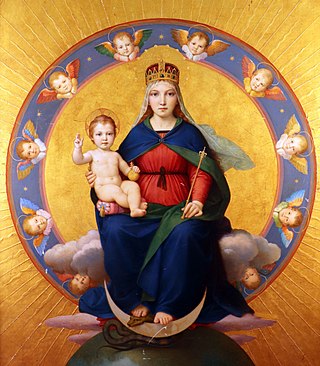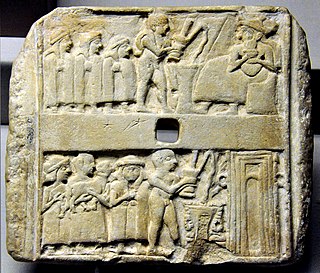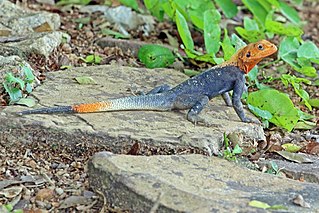Related Research Articles

Hades, in the ancient Greek religion and mythology, is the god of the dead and the king of the underworld, with which his name became synonymous. Hades was the eldest son of Cronus and Rhea, although this also made him the last son to be regurgitated by his father. He and his brothers, Zeus and Poseidon, defeated their father's generation of gods, the Titans, and claimed joint rulership over the cosmos. Hades received the underworld, Zeus the sky, and Poseidon the sea, with the solid earth available to all three concurrently. In artistic depictions, Hades is typically portrayed holding a bident and wearing his helm with Cerberus, the three-headed guard-dog of the underworld, standing at his side.

In Norse mythology, Heimdall is a god. He is the son of Odin and nine mothers. Heimdall keeps watch for invaders and the onset of Ragnarök from his dwelling Himinbjörg, where the burning rainbow bridge Bifröst meets the sky. He is attested as possessing foreknowledge and keen senses, particularly eyesight and hearing. The god and his possessions are described in enigmatic manners. For example, Heimdall is golden-toothed, "the head is called his sword," and he is "the whitest of the gods."

In Greek mythology, Europa was a Phoenician princess from Tyre and the mother of King Minos of Crete. The continent of Europe is named after her. The story of her abduction by Zeus in the form of a bull was a Cretan story; as classicist Károly Kerényi points out, "most of the love-stories concerning Zeus originated from more ancient tales describing his marriages with goddesses. This can especially be said of the story of Europa."

Cain is a biblical figure in the Book of Genesis within Abrahamic religions. He is the elder brother of Abel, and the firstborn son of Adam and Eve, the first couple within the Bible. He was a farmer who gave an offering of his crops to God. However, God was not pleased and favored Abel's offering over Cain's. Out of jealousy, Cain killed his brother, for which he was punished by God with the curse and mark of Cain. He had several children, starting with Enoch and including Lamech.

Dagr is the divine personification of the day in Norse mythology. He appears in the Poetic Edda, compiled in the 13th century from earlier traditional sources, and the Prose Edda, written in the 13th century by Snorri Sturluson. In both sources, Dagr is stated to be the son of the god Dellingr and is associated with the bright-maned horse Skinfaxi, who "draw[s] day to mankind". Depending on manuscript variation, the Prose Edda adds that Dagr is either Dellingr's son by Nótt, the personified night, or Jörð, the personified Earth. Otherwise, Dagr appears as a common noun simply meaning "day" throughout Old Norse works. Connections have been proposed between Dagr and other similarly named figures in Germanic mythology.
The Tupi-Guarani mythology is the set of narratives about the gods and spirits of the different Tupi-Guarani peoples, ancient and current. Together with the cosmogonies, anthropogonies and rituals, they form part of the religion of these peoples.

Nut, also known by various other transcriptions, is the goddess of the sky, stars, cosmos, mothers, astronomy, and the universe in the ancient Egyptian religion. She was seen as a star-covered nude woman arching over the Earth, or as a cow. She was depicted wearing the water-pot sign (nw) that identifies her.
Jarylo, alternatively Yaryla, Yarilo, Iarilo, Juraj, Jurij, or Gerovit, is an alleged East and South Slavic god of vegetation, fertility and springtime.
The Lozi people believed in a creator god, whom the Lozi call Nyambe. Nyambe's wife was Nasilele and his mother was Ngula. Nyambe is said to have created both his wife and his mother. He is also said to have created everything else that exists, including the heaven, the Earth and all the plants and animals.

The Woman of the Apocalypse is a figure–often considered to be a reference to the Virgin Mary in Catholic theology–described in Chapter 12 of the Book of Revelation.

Sumerian religion was the religion practiced by the people of Sumer, the first literate civilization found in recorded history and based in ancient Mesopotamia, and what is modern day Iraq. The Sumerians widely regarded their divinities as responsible for all matters pertaining to the natural and social orders of their society.

Inca mythology is the universe of legends and collective memory of the Inca civilization, which took place in the current territories of Colombia, Ecuador, Peru, Bolivia, Chile, and Argentina, incorporating in the first instance, systematically, the territories of the central highlands of Peru to the north.

Agadzagadza is a trickster figure from the mythology of the Bura people, one of the population groups of Nigeria. He is a male agama lizard and appears as part of an aetiological explanation for the origins of death in their culture.
Sudika-mbambi is a hero and son of Kimanaueze and is an Ambundu mythological figure. He is featured in several Ambundu legends and is well-known for his feats as a child hero in Angolan folktales. His story also became the origin myth for thunderstorms, with Sudika-mbambi representing thunder.
Kabundungdulu is the twin brother of Sudika-mbambi and is an Ambundu mythological figure. He is part of an origin myth for thunderstorm, where he represents the sound of a thunder’s echo.
Mwuetsi is a heroic figure in the mythology of Makoni tribe in Zimbabwe. He is part of Makoni creation myth, serving the role of the first human created by the sky god, Maori.
Obassi is the supreme creator god of the people of Ekoi, who is based in Nigeria and Cameroon.
Ngewo is the supreme creator god of the people of Mende from Sierra Leone.
Njambe is the supreme creator god figure in the traditional religion of the Loki or Boloki people, who are primarily based in the Democratic Republic of Congo. According to anthropologist John H. Weeks, Njambe is also used to refer to a deity associated with sickness and death [2]. He is prominent in Boloki myths regarding the origin of death [1] [3].
Kejok is a mythic hero figure in the traditional religion of the Dinka people, who dwell in present-day Sudan.
References
- 1 2 Lynch, Patricia Ann; Roberts, Jeremy (2010). African Mythology, A to Z. Infobase Publishing. ISBN 978-1-4381-3133-7.
- 1 2 "Libanza and Nsongo Move to the Heavens". Oxford Reference. Retrieved 2021-02-15.
- 1 2 "Libanaza Punishes the Slothful". Oxford Reference. Retrieved 2021-02-15.
- 1 2 "LIBANZA - the Bangala and Upoto God of Creation (African mythology)". Godchecker - Your Guide to the Gods. Retrieved 2021-02-15.
This article needs additional or more specific categories .(August 2024) |